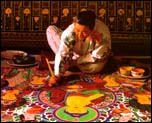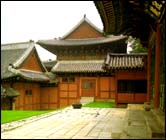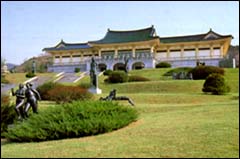![]()
| 1. Culture Korean culture has blossomed during her long history. Though affected by other Asian cultures, its roots lie deep within the creative Korean psyche, and it has tended to spread rather than be encroached upon. Japan especially has adopted many Korean ideas and customs. The delicate styling and fine craftsmanship of celadon pottery illustrates the refinement of the culture well, even from as far back as the Three Kingdoms period. Korea has also spawned some great inventions: its first printing systems predate Gutenberg's, the famous 'Turtle Ship' was the first ever iron-clad battleship, and the Korean alphabet, devised by a group of scholars in the 15 century, was so effective that it remains largely unchanged today. The reasons behind Korea's rapid economic development can be found in this innate creativity. 2. Cultural Attractions Buddhism has played a powerful role in Korean art. A large number of excellent examples of Korean artwork and architecture can be found in Buddhist temples and paintings. During the Choson Dynasty, Confucianism became a leading inspiration for the noblemen to whom the arts of calligraphy and painting were essential. They have left a legacy of fine brushwork from which contemporary artists have benefited from. 2.1 Traditional Art  Korea has a long and distinguished cultural history. The current trend in Korean art is the harmonious combination of traditional and modern styles, revealing the historical roots and influences of Korean art. 2.2 Painting Tomb murals from the Three Kingdoms Period are the earliest examples of Korean painting. Mythological beasts such as dragons and flying horses show an imaginative and creative spirit. Throughout the Unified Shilla and Koryo Periods, Buddhism prevailed in every field of life, thus leaving a rich collection of icon paintings. In the late Koryo Dynasty, ink and brush paintings of the four "noble plants", (cherry blossom, orchid, chrysanthemum, and bamboo), which symbolized traditional virtues, became popular. Artists of the Choson Dynasty produced innovative masterpieces embodying the Korean spirits and perspectives. There are humorous animal pictures, scroll paintings of dreamlike, mist-clad mountains, and insightful sketches of everyday life done in brush and ink. Paintings with folk custom and nature themes flourished in the latter half of the 18th century. Shin Yun-bok was a celebrated master of this genre. 2.3 Calligraphy Calligraphy, the art of brush writing, is a traditional art form in Korea, which has exerted a strong influence on social and cultural life and is still highly respected today. 2.4 Architecture  Four factors have shaped traditional Korean architecture: religions, the availability of materials, the natural landscape, and an aesthetic preference for simplicity. Gently sloping rooflines and sturdy, undecorated pillars characterize its simplicity, harmony, and practical utility. Korea has many original wooden and stone structures, some dating back over a thousand years. There are also many skillful reproductions. Traditional architectural designs are also incorporated in many modern buildings throughout the country. 2.5 Pottery One of the most significant achievements in Korean art, the perfection of celadon, was accomplished during the Koryo Dynasty. Korean artisans developed a superbly controlled glaze that was both beautiful and unique because it fully utilized the properties of Korea's rich clay. The highest praise is given to the color of the glaze - a delicate kingfisher green celadon inlaid with a pictorial underglaze which is called sanggamch'ongja and occupies a central position among Koryo celadons. The motifs and decorations found on the celadon are additional reasons for its great popularity among art lovers. 2.6 Modern Art With its characteristic blend of the traditional and modern arts and the balance of influences from the east and the west, Korean contemporary art has surged in popularity. Most artists try to be accessible to their audience, and there are many exhibitions and galleries in any major city, the largest collections of which are in Anguk-dong and Taehangno areas in Seoul. 2.7 Museums  Visiting the museums of a country is a valuable opportunity to see its historic treasures and cultural legacies. As in other countries with long histories, many national, municipal and university museums, as well as a number of private institutions, preserve Korea's colorful past. 3. Traditional Performance Koreans have always had a deep love for music and dance. Traditional Korean dance and musical performances can be a memorable part of visiting Korea. These performances can be seen regularly each Saturday at the Korean Traditional Performing Arts. Some examples of things you might see are: 3.1 Court music: Traditional Korean music can be classified as court or folk music. Court music is slow, solemn and complex. It is performed regularly at the National Theater. 3.2 P'ansori: This narrative folk song tells a long, dramatic story. 3.3 Folk songs: Folk songs express the emotions of the working class people. 3.4 Samulnori (farmers' dance): Four music instruments are used in Samulnori: Buk (drum), Ching (gong), Chang-gu (hourglass drum) and Kkoenggwari (a type of a gong). 3.5 Sandaenori (mask dance): Korean mask dances are silent folk dramas that satirized the high society prevalent when they were developed, over 200 years ago. They contain many Buddhist and Shamanism elements. 3.6 Madangnori: These performances are similar to the Western-style musical. 3.7 Traditional dance: Traditional Korean dance is divided into three main types: court, folk and religious. Among all Korean dances, the best known are the fan dance and the drum dance. *[Sujech'on,] the most famous composition of court music, performed on wind instruments Sujech'on is a type of chong'ak, literally "proper or correct music", which is comprised of both instrumental and vocal pieces which were generally cultivated by the upper class literati of the Choson society. * [T'aep'yongmu,] The Court Dance One of the many court dances, Taep'yongmu originates with Han Son-jun (1874-1941), who founded the Choson Dance Institute in 1933. The lone female dancer is dressed in the rhythms of Shamanistic music. T'aep'yongmu has been designated an Intangible Cultural Asset in order to assure its preservation. * [Kayagum,] a twelve-stringed zither The Kayagum is similar to the Chinese cheng and the Japanese koto in structure but is played differently and has a different timber. The Kayagum dates back to the sixth century during the rule of King Kasil of the Kaya Kingdom. The thumb, index finger and middle finger of the right hand pluck the strings, while the index and middle fingers of the left hand press on the strings of the left side of the movable bridges. * [Geomungo] It has 6 lines and 16 flats called 'Goae'. In view of the mechanism that allows it to produce sound, it is similar to guitar, in that the pitch is decided by the flat location of a finger. The left fingers are placed on the Goae to control pitch and the right hand grasps a stick called 'Sul-Dae' and plucks the strings. The sound of the Geo-Mun-Go is less clear and sharp than most string instruments, but nevertheless it can fully convey the feeling of people. |
